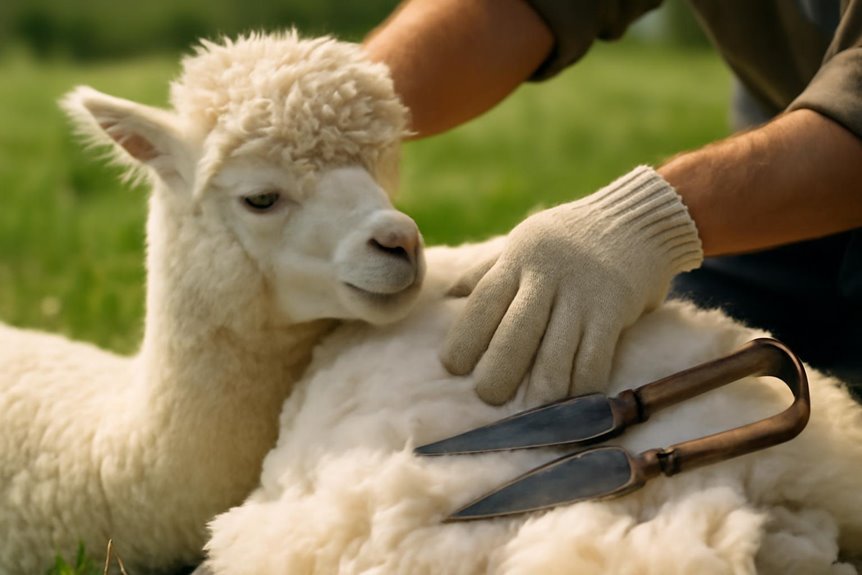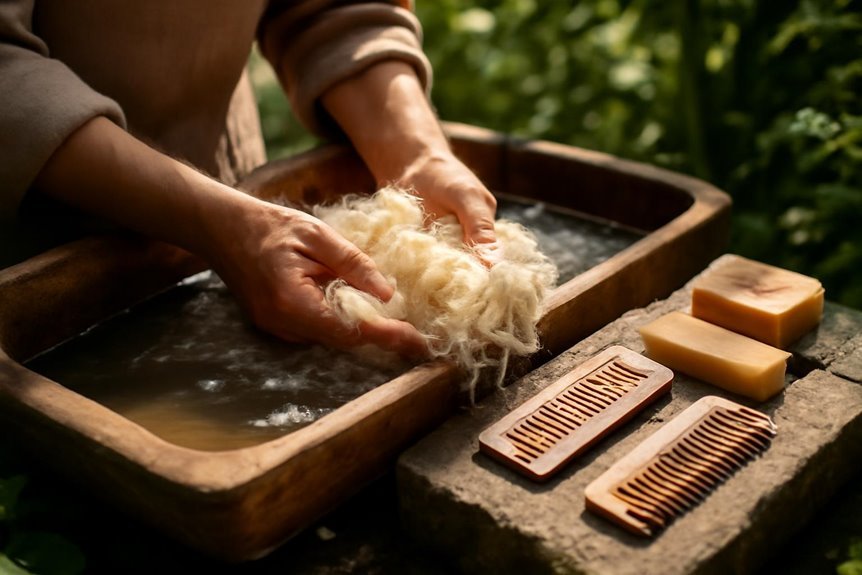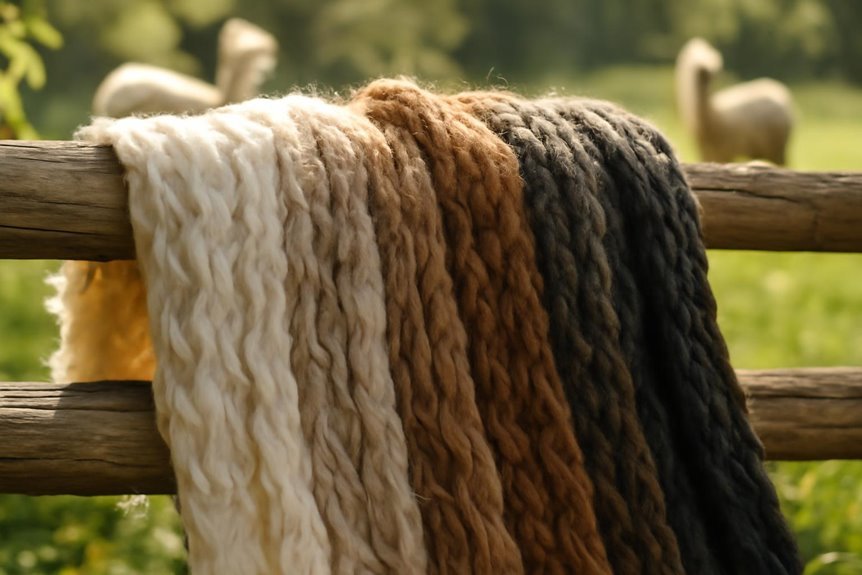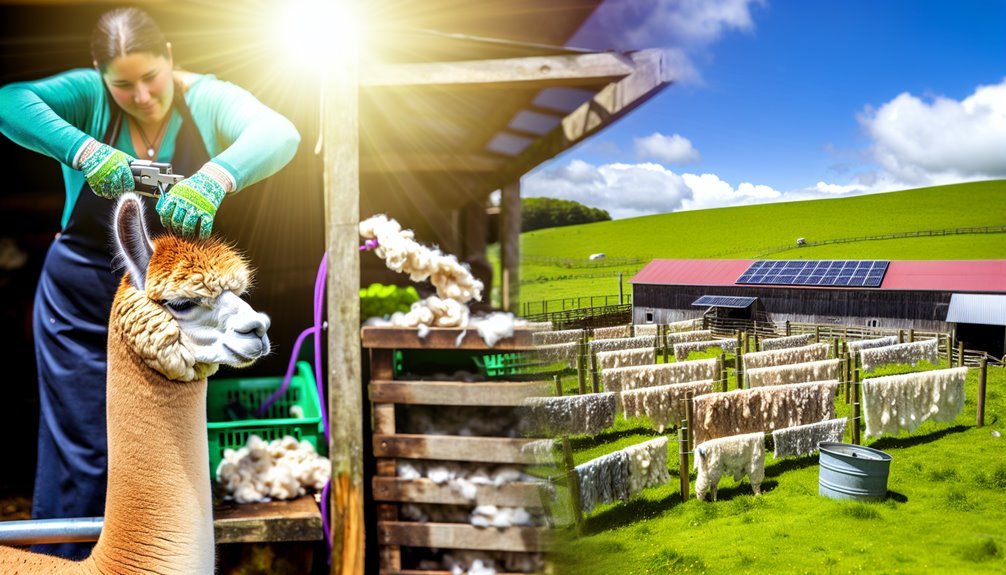10 Best Sustainable Methods for Alpaca Fiber Production
If you want the best sustainable alpaca fiber, start with ethical shearing and rotational grazing to protect pastures. Use organic, chemical-free farming and turn alpaca manure into natural fertilizer. Cut water use in processing and support small farmers who preserve traditions. Promote biodiversity with alpaca-friendly land management and reduce your carbon footprint by choosing local production. Also, focus on waste reduction and recycling. Keep exploring this to discover how these methods truly benefit both the environment and communities.
Key Takeaways
- Use ethical alpaca shearing with gentle, skilled artisans to minimize animal stress and support sustainable fiber harvesting annually.
- Implement rotational grazing to maintain pasture health, promote biodiversity, and prevent soil erosion from overgrazing.
- Utilize alpaca manure as a natural, nitrogen-rich fertilizer to enhance soil quality and reduce synthetic chemical use.
- Employ water-efficient fiber cleaning methods, recycle water, and use biodegradable detergents to minimize water consumption and pollution.
- Prioritize localized production and overland transport to reduce carbon emissions and maintain transparent, low-impact supply chains.
Ethical Alpaca Shearing Practices

Although alpaca shearing happens just once a year in the spring, it’s a carefully managed process that puts the animals’ well-being first. On ethical alpaca farms, skilled artisans use gentle techniques during alpaca shearing to minimize stress and discomfort. These farms often keep smaller herds, allowing them to provide individual care, which supports more humane fiber production. The fleece is harvested naturally, without chemicals or pesticides, making it an excellent choice for sustainable fashion. Because alpacas have soft-padded feet, they cause minimal land damage, preserving soil health during shearing. By choosing fiber from these ethical alpaca farms, you’re supporting a sustainable and responsible approach to fiber production that values both animal welfare and environmental health.
Rotational Grazing to Preserve Pasture Health
When you rotate alpacas between pastures, you give the grass time to recover and the soil a chance to stay healthy. Rotational grazing helps maintain soil health by preventing overgrazing and encouraging plant regrowth. Alpacas’ soft, padded feet reduce soil compaction, which supports biodiversity and ecosystem balance. Their natural grazing habits promote healthy roots, ensuring pastures thrive longer. Plus, alpaca dung acts as an organic fertilizer, enriching soil nutrients naturally.
Rotating alpacas protects soil health, boosts biodiversity, and naturally nourishes pastures for lasting growth.
- Prevents overgrazing and soil degradation
- Supports a diverse range of plant species
- Minimizes soil compaction and erosion
- Encourages healthy grass regrowth
- Supplies natural, organic fertilizer to pastures
Organic and Chemical-Free Farming Techniques
You’ll appreciate how alpacas naturally graze without harming the land, keeping soil healthy and grass thriving. Their fiber is harvested through traditional shearing methods that don’t use any pesticides or chemicals. This approach keeps both the animals and environment safe while supporting sustainable farming.
Natural Grazing Practices
Because alpacas use natural grazing methods, their pastures regenerate quickly without needing chemical fertilizers or pesticides. This makes natural grazing practices an essential part of sustainable agricultural practices in alpaca farming. You’ll notice the environmental impact is minimal since alpacas have padded feet that cause little soil disturbance, reducing erosion. Their manure enriches the soil naturally, supporting healthy pastures. Plus, alpacas require less food and water than other fiber animals, making them eco-friendly.
- Pastures regenerate rapidly without chemicals
- Minimal soil erosion from padded feet
- Manure acts as a natural high-nitrogen fertilizer
- Small herds support organic, sustainable farming
- Lower resource needs reduce environmental impact
Embracing these methods guarantees your alpaca farming stays green and sustainable.
Pesticide-Free Shearing Process
Although the shearing process might seem straightforward, guaranteeing it’s done without chemicals or pesticides is key to maintaining the purity of alpaca fiber. When you choose a pesticide-free shearing process, you’re supporting both the well-being of alpacas and the environment. Alpacas are sheared once a year in a humane, stress-free manner that avoids harmful substances. This sustainable approach not only produces high-quality alpaca fiber but also prevents soil and water contamination. By adhering to organic, chemical-free farming techniques during shearing, you help maintain the integrity of the land and contribute to the environmental benefits of alpaca farming. Choosing this method guarantees your fiber is biodegradable, renewable, and truly sustainable from farm to finished product.
Utilizing Alpaca Manure as Natural Fertilizer
Anyone interested in sustainable farming will find alpaca manure to be a valuable resource. This natural fertilizer is packed with nitrogen and potassium, essential for healthy soil and robust plant growth. By composting alpaca manure, you reduce waste and create a nutrient-rich amendment for your crops and gardens. Using it supports regenerative agriculture by improving soil structure and reducing reliance on synthetic fertilizers. Plus, each alpaca produces 5 to 10 pounds of manure daily, making it a consistent and eco-friendly input.
- Rich in nitrogen and potassium
- Compostable to enrich soil health
- Supports sustainable farming practices
- Enhances soil structure and fertility
- Reduces need for chemical fertilizers
Utilizing alpaca manure helps you recycle nutrients and promote a healthier ecosystem naturally.
Minimizing Water Usage in Fiber Processing

You can cut down water use in alpaca fiber processing by adopting water-efficient cleaning techniques that reduce waste without sacrificing quality. Recycling and reusing water during washing and dyeing also play a big role in conserving this precious resource. By focusing on these methods, you help make alpaca fiber production even more sustainable.
Water-Efficient Cleaning Techniques
When you’re working with alpaca fiber, cutting down water use during cleaning not only saves resources but also helps protect the environment. Adopting water-efficient cleaning techniques is essential for sustainable practices in alpaca fiber production. You can considerably reduce water usage without compromising fiber quality by:
- Using biodegradable detergents and organic cleaning agents to minimize water pollution
- Applying dry cleaning or steam cleaning methods to lower water dependency
- Optimizing cleaning processes to cut water usage by up to 50%
- Incorporating closed-loop water systems for water recycling
- Monitoring water usage carefully to identify further savings
Recycling and Reusing Water
Although alpaca fiber processing typically demands large amounts of water, recycling and reusing that water can drastically cut consumption. By implementing closed-loop water systems, you can filter and reuse water for washing and dyeing, minimizing fresh water intake and wastewater. Efficient water management practices can reduce water usage by up to 90%, making your operation far more sustainable. Supplementing with rainwater harvesting further decreases reliance on municipal sources. Using eco-friendly detergents during washing guarantees that recycled water stays free of harmful chemicals, promoting a cleaner, safer processing cycle. Embracing these sustainable production methods not only conserves water but also supports environmental health, making your alpaca fiber production truly eco-conscious and responsible.
Harnessing Natural Color Variations to Reduce Dyeing

Since alpacas naturally produce 22 different fiber colors, you can greatly cut down on synthetic dye use by embracing these variations. Using natural colors from alpacas supports sustainable production by reducing the carbon footprint tied to chemical dyeing. This approach conserves water, lowers energy consumption, and minimizes harmful waste. Plus, it keeps traditional alpaca farming practices alive. Here’s how you can make the most of natural color variations:
- Select fibers in their native shades to avoid dyeing.
- Promote biodiversity by valuing diverse alpaca colors.
- Reduce chemical runoff by skipping synthetic dyes.
- Lower water and energy use during production.
- Support eco-friendly alpaca farming methods in the Andes.
Supporting Local Communities and Small-Scale Farmers
When you support alpaca fiber production, you’re empowering thousands of smallholder families who rely on sustainable farming for their livelihoods. This local focus helps strengthen communities and preserves traditional practices that benefit the environment. By choosing alpaca products, you contribute directly to a resilient and fair local economy.
Empowering Smallholder Families
By supporting alpaca fiber production, you’re directly empowering around 82,000 smallholder families in Peru who rely on this sustainable livelihood. These alpaca herders manage family-run farms that preserve cultural heritage and traditional textile methods. Your choice helps maintain local knowledge while fostering economic stability in rural communities.
- Encourages sustainable livelihood through responsible alpaca farming
- Supports smallholder families using time-honored techniques
- Promotes regenerative agriculture benefiting soil health
- Preserves Andean cultural heritage and craftsmanship
- Connects global markets with ethical, community-based production
Strengthening Local Alpaca Economies
Although alpaca fiber production supports thousands of families across the Peruvian Andes, its impact goes beyond individual livelihoods—it strengthens entire local economies. When you invest in alpaca fiber, you’re directly aiding about 82,000 smallholder families who rely on this sustainable practice for income. Most of this fiber comes from the Peruvian Andes, highlighting how essential local economies are in this sector. By embracing sustainable practices like responsible grazing, these farmers protect the environment while boosting their earnings. Plus, the growing global demand for alpaca fiber means expanding opportunities for small-scale farmers like you. Supporting these communities helps preserve traditional farming methods and fosters strong community ties, ensuring the resilience and prosperity of local alpaca economies for generations to come.
Promoting Biodiversity Through Alpaca-Friendly Land Management
Since alpacas graze selectively on grasses, they naturally encourage the growth of diverse plant species, which helps maintain a balanced ecosystem on your land. By promoting biodiversity through alpaca-friendly land management, you support healthier soils and thriving ecosystems. Alpacas’ natural fertilizer enriches the ground without harmful chemicals, enhancing sustainability. Their low land and resource needs make sustainable land management easier and more effective. Here’s how alpacas benefit your land:
Alpacas promote biodiversity and ecosystem health through selective grazing and natural fertilization.
- Prevent overgrazing by targeting specific grasses
- Support a wider range of plant and animal species
- Reduce reliance on chemical fertilizers with natural fertilizer
- Lower environmental impact due to minimal resource use
- Maintain balanced plant communities for long-term ecosystem health
Using alpacas is a smart choice for promoting biodiversity and sustainable land management.
Reducing Carbon Footprint With Localized Production
When you choose alpaca fiber produced locally in Peru, you cut down on transportation emissions that come with long-distance shipping. Localized production keeps the entire supply chain close to the source, considerably lowering the carbon footprint compared to global shipping routes. By relying on overland transport instead of air or sea freight, you further reduce environmental impact, aligning your choices with strong environmental sustainability goals. Supporting family-run farms and local processing also enhances product traceability while minimizing greenhouse gas emissions. Additionally, alpaca farming practices promote soil health and carbon sequestration, contributing to emission reductions. Choosing PFAS-free materials and compostable packaging alongside localized production guarantees every supply chain stage stays focused on reducing your overall carbon footprint and supporting sustainable alpaca fiber production.
Implementing Waste Reduction and Recycling Strategies
Cutting down your carbon footprint through localized alpaca fiber production is just one part of creating a sustainable supply chain. To truly minimize your environmental footprint, focus on implementing waste reduction and recycling strategies. You can adopt several eco-friendly practices to guarantee alpaca fiber production stays green:
Reducing your carbon footprint starts with local alpaca fiber production and smart waste management strategies.
- Use alpaca dung as natural fertilizer, reducing chemical inputs and boosting soil health.
- Establish closed-loop recycling by repurposing old alpaca garments to cut textile waste.
- Choose biodegradable packaging to limit plastic pollution in shipping.
- Partner with local artisans to turn alpaca fibers into new textiles or crafts, supporting community economies.
- Educate consumers on garment care and recycling to extend product life and promote responsible disposal.
These steps help you embrace sustainability while reducing waste and conserving resources effectively.
Frequently Asked Questions
How Is Alpaca Fiber Harvested?
When you harvest alpaca fiber, you follow fiber harvesting techniques like gentle shearing best practices in spring, prioritizing animal welfare considerations. Afterward, post harvest processing guarantees clean, high-quality fiber without stressing the animals.
Are Alpacas the Greenest Animal?
You’ll find alpacas have eco friendly characteristics like low impact grazing and minimal waste production, helping preserve their natural habitat. While not the absolute greenest, they’re definitely among the most sustainable livestock options you can choose.
What Is the Best Alpaca Fiber?
You’ll find the best alpaca fiber comes from select alpaca breeds with fine fiber qualities like softness and strength. Natural dye techniques and current market trends favor baby alpaca, prized for luxury and eco-friendly appeal.
Is Alpaca Fiber Sustainable?
You’re in the driver’s seat when choosing alpaca fiber—its low environmental impact and unique fiber characteristics shine. With ethical practices and industry growth on the rise, alpaca’s sustainability is no flash in the pan.








Our picks
Alpaca & Wool Felted Sole Inserts: Comfy Upgrade?
Best Alpaca Socks for Hiking: Ultimate Comfort and Durability on Trails
Best Alpaca Halter for Comfort and Control